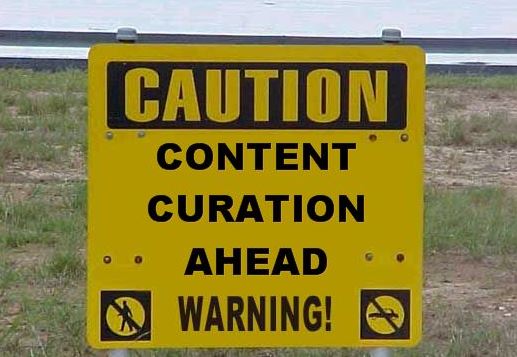
By Kerry Gorgone, {grow} Contributing Columnist
“Content curation” is a powerful tool for marketing. By sharing someone else’s relevant, helpful content, you prove to your audience that you care about helping them—not just boosting your own site traffic.
But when does “curation” turn into copyright infringement? Too often, people will copy/paste an entire article onto their own site, then become indignant when the original author asks them to take it down.
This is from an actual email exchange with an agency website that did just that:
If you feel this is somehow in violation then feel free to waste your money and have your lawyers contact me. But be assured that its [sic] a two way street and I would advise you contacting direct next time before slandering us with a false statement like you did on our blog.
I am honestly shocked at your discord, the usual response we get is a ‘thank you’ and often an offer of a guest blog. We have provided both valuable links and distribution through our channels.
You’re “shocked” that someone didn’t thank you after you copied the entire text of their article and posted it on your own site? I find that difficult to believe, but let’s assume that some people genuinely don’t understand curation, copyright, or fair use.
In our litigious society, you MUST understand the difference between helpful curation and using content in a way that breaks the law. It boils down to understanding the concept of fair use.
What is Fair Use?
Fair use is a defense to a claim of copyright infringement. Just because you give somebody credit doesn;t mean it’s legal. Many people say that their use of someone else’s creative work is “fair” in a disclaimer post on the bottom of the page, as though that will shield them from liability. Only it won’t.
You only get to raise the “fair use” argument once you’ve been sued (and spent money on legal fees to defend yourself against the copyright infringement claim).
If you’ve never been sued, let me give you a visual: think about what it would look like if your business started hemorrhaging money, and nothing could stop the bleeding. Not a good scenario.
Keeping your content safe
There is no specific amount of someone else’s copyrighted work that you can always legally use. There are many “copyright urban legends” asserting things like “you can use 30 seconds of any movie without worrying” or “you can use 10 seconds of any song before you have to worry about copyright.” There simply is no magic number in a regulation somewhere.
For text, there is no set percentage of a work you can use without permission: whether the use is “fair” (and therefore legal) depends on the nature of the use and the specific facts of each case.
Bottom line, you can’t know at the outset whether your use of someone else’s copyrighted work constitutes “fair use” in the eyes of the law.
Once you’ve been sued for infringement, the court applies four factors to the facts of your case to assess whether the use was “fair:”
- The purpose and character of the use, including whether such use is of commercial nature or is for nonprofit educational purposes.
- The nature of the copyrighted work.
- The amount and substantiality of the portion used in relation to the copyrighted work as a whole.
- The effect of the use upon the potential market for, or value of, the copyrighted work.
Here is the big concern: Did you profit from using the other person’s work? Did you sell posters of an artist’s painting, or publish a book that’s really just a compilation of other people’s blog posts?
And how much of the other person’s work did you use? A few key phrases to entice people to click the link to the original post, or the entire text of the post, word for word?
The court will also look at whether your use of the content undercuts the market for the creative work. If you’re selling prints of someone else’s photo, you’re obviously impacting an opportunity to sell the original prints.
By contrast, if you share a 30-second video of your adorable baby racing around the kitchen and dancing to a Prince song, are you undercutting the market for “Let’s Go Crazy?” Doubtful. And the Ninth Circuit U.S. Court of Appeals agrees.
But if I re-post your entire article on my website, there will be no reason for anyone to visit your website. I’m essentially hijacking your site traffic. And linking to your original post in my carbon copy doesn’t make up for that: no one’s going to click that link when they can read the entire article without clicking.
Reposting someone else’s article word for word is not curation: it’s copyright infringement.
Safe curation
THIS is curation: I publish a blog post in which I say “Ann Handley raises an important point about brand bias in storytelling today on her blog,” with a link back to her site.
In this instance, I might use a small snippet or quote from Ann’s article, but I’m clearly not trying to steal her traffic. In fact, I’m actually trying to drive more traffic to her article. This is a use of content much more likely to be deemed “fair.”
Using parts of someone else’s work to criticize it or comment on it is also more likely to be fair use. It’s the copyright equivalent of saying “this stinks: smell it.” You’re not trying to take credit for the smelly stuff in the jar: you’re just commenting on how smelly it is, and warning others.
Fair use and visual content
Be especially careful using someone else’s visual content (pictures, videos, infographics) without permission. Some people post their copyrighted photos online and strategically optimize them for search so that people will easily find them and probably use them in their own digital content.
As soon as someone uses the content, the copyright holder pounces, threatening a lawsuit and demanding a financial settlement. Basically, it’s a trap!
Only use other people’s photos or visual content if you have their written permission.
Or, avoid the whole mess and use your own photos. It’s easier than ever now, with smartphone cameras taking such high-quality images.
You could pay to use stock photos, but your content will express your own personality and style better if you use your own.
The benefit of Creative Commons
Some authors and artists choose to release their work under a Creative Commons license. These licenses allow companies or individuals to use the work, provided people comply with the terms of the license.
Some Creative Commons licenses require only that you give credit to the author. Others are more restrictive, specifying “no commercial use” or “no derivative works” (new works based on the original).
One caveat: you can’t be sure that the person who uploaded the “Creative Commons” photo and chose the license actually owns it! So, once again, taking your own pictures and creating your own visuals is the safest option.
And for those who think copy/pasting is curation, I quote Dr. Peter Venkman from Ghostbusters: “My friend, don’t be a jerk.”
For more detailed information on the issue of fair use, visit the United States Copyright Office website.
Kerry O’Shea Gorgone is a writer, lawyer, speaker and educator. She’s also Instructional Design Manager, Enterprise Training, at MarketingProfs. Kerry hosts the weekly Marketing Smarts podcast. Find Kerry on Google+ and Twitter.
Illustration courtesy signgenerator.org



